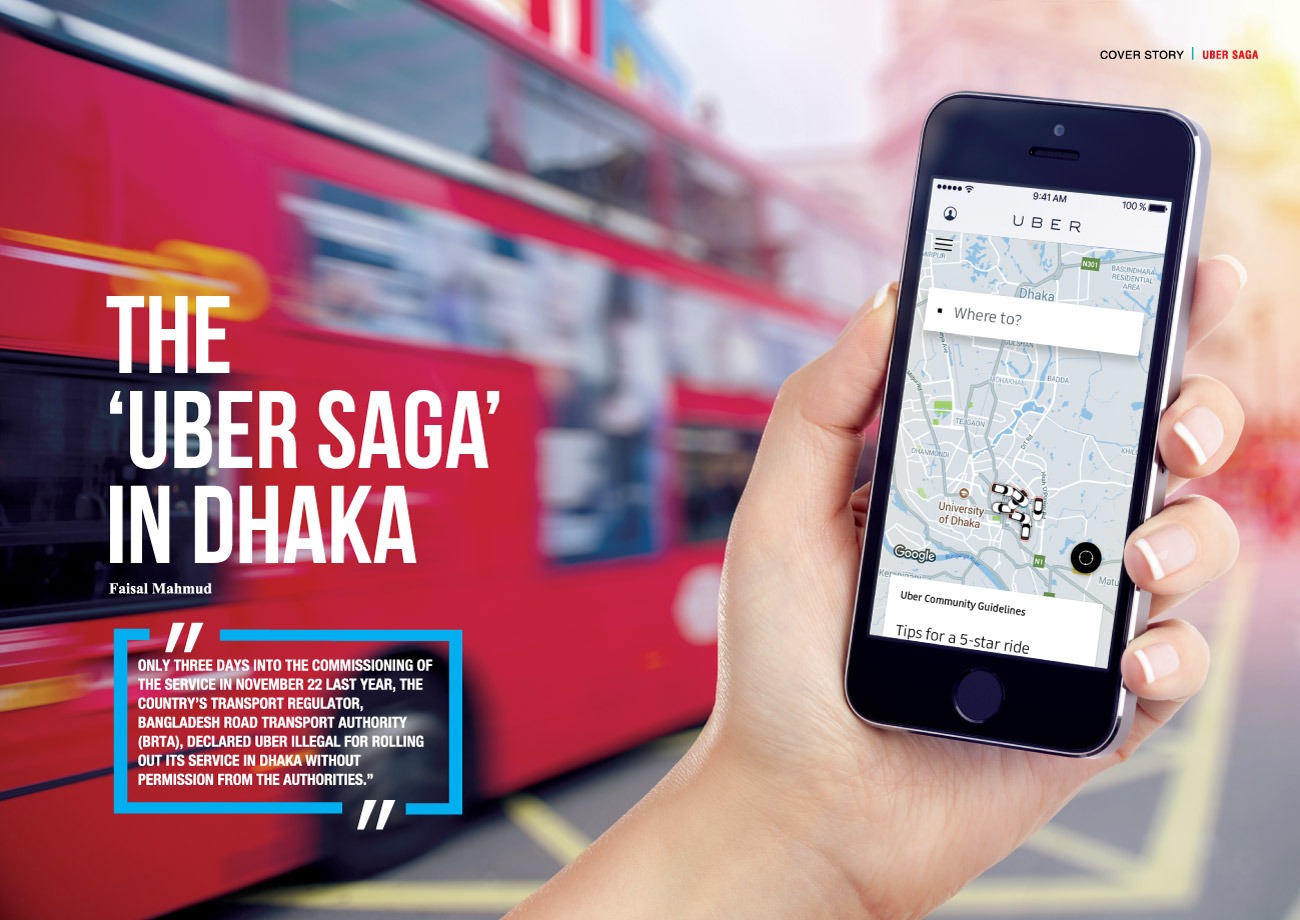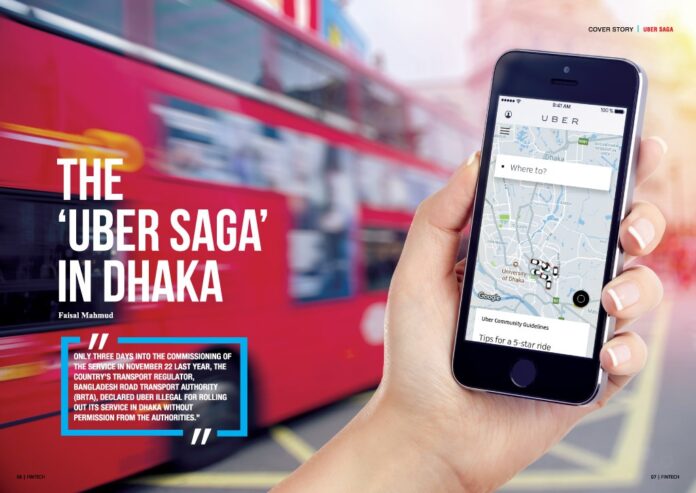
Over the past ten months, ride-sharing app Uber has altered the way we think about commuting inside the city. Now, by simply downloading a free application in our phones, setting up an account and pressing a button, we can have a driver ready to pick us up in minutes and take us anywhere for less than the price of a taxi.
This is something that was unthinkable not so long ago, especially in a city like Dhaka where rules and regulations practically make the roads for introducing any new technologies an uphill task.
Incidentally, Dhakaites’ hope for the world’s largest on-demand mobile apps-based Uber taxi services was punctured soon after it was launched by the San Francisco-based tech company that has literally revolutionized taxi experience throughout the world.
 Only three days into the commissioning of the service in November 22 last year, the country’s transport regulator, Bangladesh Road Transport Authority (BRTA), declared Uber illegal for rolling out its service in Dhaka without permission from the authorities.
Only three days into the commissioning of the service in November 22 last year, the country’s transport regulator, Bangladesh Road Transport Authority (BRTA), declared Uber illegal for rolling out its service in Dhaka without permission from the authorities.
Uber’s disputes with authorities and rival traditional taxi companies are something that is not new. But the case here in Bangladesh was curious, strange and unusual as it seemed as the multinational Uber took Dhaka market for a ride.
The ride-sharing firm, whose 2015 revenue was 1.5 billion US dollars, did not bother to seek permission from authorities. And Uber, which is available in over 74 countries and 450 cities worldwide, failed to come up with plausible clarifications in its defense to roll out the service without the regulatory consents.
The BRTA came soft after its initial roadblock
Even though Uber didn’t seek proper permission from the respective authorities in rolling out its Dhaka operation and thus was declared illegal by the transport regulator, because of skyrocketing popularity in a short span of time, the BRTA was compelled to change its stance and said that it would soon formulate a guideline for making ride-sharing services like Uber ‘legal.’
Having declared that, the BRTA formed a special committee with Nazmul Ahsan Mazumder, BRTA director of Enforcement as its head and conducted meetings after meetings to chalk out a guideline for ride-sharing app like Uber.
After about five months of forming the committee, the transport regulator came up with a draft Ridesharing ervice Guideline allowing commercial use of private passenger vehicles, including cars and motorcycles, on a trial basis.
All ridesharing companies and motor vehicles owners have to receive enlistment certificates from the Bangladesh Road Transport Authority, says the draft.The fare rate of service will be deregulated for the time being and the government will fix fare rate if the passengers express dissatisfaction with the fare, it also said Not only the private vehicles but also all commercial passenger vehicles will be able to run under the proposed guideline.
It also said that the ridesharing will be a safe, uninterrupted, affordable and quality door-to-door service which will allow private car owners to use their vehicles commercially using online-based application via smart phone.
The proposed conditions stipulated that the operators must form a public or private limited company with TIN number, there must be system for lodging complaints, an operator must have minimum 200 motor vehicles under it, all private passenger vehicles including cars, jeeps, microbuses, auto-rickshaws, ambulances and motorcycles will be include in the service and all vehicles and drivers must have updated legal documents.
The service can be availed by highest two passengers sharing the fare on the same route and the companies have to provide data of the passengers and drivers to the BRTA if needed. If any operator or drivers violate any clause of the draft, they will be tried under the MVO and existing laws.
The challenges ‘unaddressed’ so far
Even though the BRTA has come up with a draft guideline to make services like Uber legal, there are several issues still remain unaddressed by the transport regulator. This is because the transport authorities are still finding it a daunting task to formulate a proper identification policy and taxation structure for app-based taxi service Uber.
First of all, the BRTA still hasn’t a clue about the number of cars get registered with Uber for providing the service. Nazmul Ahsan Mazumder admitted it to Fintech, saying that they are still in the dark over the number of vehicles providing Uber services.
“We asked them, but they didn’t disclose it.” The BRTA director said that they were facing two main problems with Uber. “One is identification and the other one pertains to taxation,” he added.
Mazumder said since a large number of people was happy using this global taxi hailing app service, they wanted to legalise it. “As of now, the service is illegal as it cannot be regulated with any of the provisions under the existing Act.”
The BRTA official said there was no way of finding out whether a car was being used for Uber service. “The whole operation is conducted via mobile phones and the enforcement officials on the road cannot possibly check that,” he added.
In neighbouring India, the Delhi government had imposed a general ban on all app-based taxi services, including Uber, on December 8, 2014, after a 26-year-old female passenger was allegedly raped by her driver.
Following this, India’s ministry of road transport had issued guidelines for ride hailing services such as Uber (Uber Technologies Inc.) and Ola (ANI Technologies Pvt. Ltd), in October 2015, identifying them as on-demand information technology-based transportation aggregators and not as taxi companies.
India’s guidelines, however, were favourable to taxi-app operators like Uber in the sense that they recognized ride-sharing as a distinct type of transit service. They also did not seek to impose taxi-style rules, for instance, requiring cars to display a visible meter for identification.
In Canada, Uber-run vehicles fall under the category of private transportation company (PTC). As per these guidelines, vehicles have to display a sticker on the back window of the passenger side while operating in a PTC capacity.
Imposition of a unique identity for Uber-run vehicles, however, depends on individual government regulations across the world. Most of the countries do not impose any specific identification for Uber vehicles.
Mahbubur Rahman, a Bangladeshi student who drives for Uber part time in Charleston in North Carolina in the US, told The Independent that identification was needed for Uber so that it could be regulated, and more importantly to bring it under the taxation structure.
“In Charleston, if you’re an Uber driver, you’ll need to declare the income you’ve generated in the financial year on your tax returns. But in many US states, the tax is not paid by the driver, but Uber cuts a portion from fares as taxes,” he added.
Rahman, who hails from Dhaka, said that in a country like Bangladesh, which only has around two million taxpayers out of a population of 160 million, formulation of proper taxation is important.
BRTA director Mazumder too admitted that finding a proper taxation structure for Uber has become their main headache now. “We have already asked the National Board of Revenue (NBR) to assist us in this matter,” he said.
Interestingly, Uber now operates in 581 cities in 81 countries across the world, but this multi-billion dollar company does not have any fixed policy to share revenue with the government in the form of taxes.
US-based Fortune magazine reported that Uber declined to make any of its executives available to discuss its corporate structure or its approach to tax planning when it was filing a report on the loopholes of the app-based taxi service’s taxation structure.
Uber office remains overly ‘diplomatic’
This correspondent tried to contact Dhaka’s Uber office for getting clarifications on some of the issues but failed to get any ‘precise answers’. Uber’s communication in Dhaka is handled by a PR agency named Benchmark.
When sent a mail, it replied on behalf of Uber, ““At Uber, we continuously experiment with products to ensure that we can provide the most reliable, safe, comfortable and affordable ride to everyone, everywhere. Our technology offers riders more choice, allows driver partners to earn sustainable incomes, and reduces congestion by encouraging people to leave their cars at home.
Riders and driver partners around the world have welcomed our ridesharing and bikesharing products and while we aspire to bring these to riders in Dhaka, we currently don’t have anything to announce.








